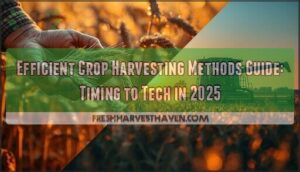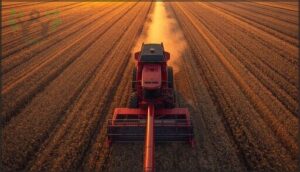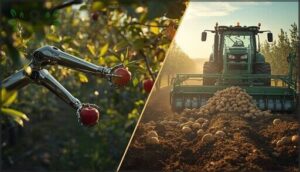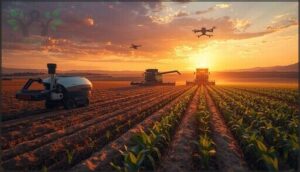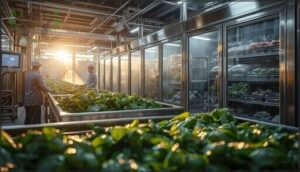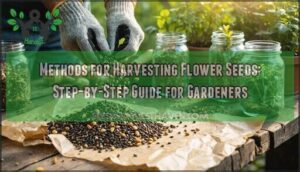This site is supported by our readers. We may earn a commission, at no cost to you, if you purchase through links.
Your crop reaches peak maturity within a 72-hour window, and missing it can cost you 15–30% of your total yield—either to quality degradation, weather damage, or market penalties. The difference between a profitable harvest and a breakeven season often comes down to knowing exactly when to mobilize your crew or equipment, then executing without bottlenecks or losses in the field.
Mechanical damage, improper handling, and delayed cooling can erase the gains you’ve worked all season to achieve, which is why an efficient crop harvesting methods guide that integrates timing, technology, and post-harvest protocols isn’t optional anymore.
In 2025, growers who combine real-time crop sensors, purpose-matched machinery, and well-organized post-harvest systems are consistently outperforming those who rely on calendar dates and guesswork. The strategies ahead walk you through each decision point—from physiological maturity indicators to robotic pickers and IoT-monitored storage—so you can capture more of what you grow and deliver it at premium quality.
Table Of Contents
- Key Takeaways
- Factors Affecting Optimal Harvest Timing
- Manual Harvesting Methods for Efficiency
- Mechanical Harvesting Techniques and Equipment
- Innovative and Sustainable Harvesting Solutions
- Post-Harvest Handling and Quality Preservation
- Maximizing Yield and Reducing Harvest Losses
- Frequently Asked Questions (FAQs)
- Conclusion
Key Takeaways
- Missing the 72-hour peak maturity window can cost you 15–30% of total yield, making precision timing through physiological indicators, moisture meters, and real-time sensors more critical than calendar-based guessing in 2025.
- Mechanical damage and delayed cooling erase seasonal gains, so integrating purpose-matched machinery with immediate post-harvest protocols—rapid precooling, hermetic storage, and IoT monitoring—directly protects both quality and profit margins.
- Manual harvesting still delivers when you’re handling delicate crops or difficult terrain, but cutting hand-picking intervals from seven days to three can slash post-harvest weight loss nearly in half while preserving premium quality.
- Data-driven harvest decisions using AI vision systems, yield monitors, and predictive analytics lift accuracy by 15% and reduce losses by targeting optimal windows, transforming guesswork into measurable economic outcomes.
Factors Affecting Optimal Harvest Timing
Getting the harvest timing right can mean the difference between a bumper crop and a costly loss. You’ll need to keep your eye on several moving targets, from what’s happening inside the plant itself to the weather forecast and market conditions.
Let’s break down the key factors that’ll help you pinpoint that sweet spot for harvesting.
Physiological Maturity and Crop Indicators
When you’re gauging physiological maturity, look beyond the calendar—watch for visual signals like color shifts and kernel black layers, track biochemical markers such as chlorophyll degradation and ethylene release, and apply quantitative indices including harvest index ratios.
These ripeness assessment tools directly impact harvest timing and crop quality. Picking too early or late undermines yield, storage life, and market value, so precision matters for your bottom line. Using harvest maturity indices helps determine the correct time for harvesting.
Moisture and Sugar Content Considerations
Once you’ve got those maturity indicators in hand, zero in on moisture and sugar content—they’re your operational benchmarks. For corn, target 23–25% moisture to balance mechanical efficiency and drying costs; soybeans should sit at 13–15% to avoid shatter losses. In grapes, Brix levels between 19–25 degrees signal best harvest timing.
Use refractometers and moisture meters to lock down these thresholds—storage stability, quality trade-offs, and your profit margin all hinge on precision measurement technologies. Producers should also understand elevator discount schedules to get the most out of revenue.
Weather and Environmental Impacts
Weather data drives everything you’ve measured, and extreme weather now dictates whether you harvest at all. Climate change has stretched frost-free periods across nearly every U.S. state, reshaping traditional harvest windows.
Yet a single heatwave can slash productivity by half, and pre-harvest rainfall degrades grain quality by up to 27 percentage points—revenue lost to environmental impact you can’t control.
A single heatwave can halve your productivity, while pre-harvest rain can slash grain quality by 27 percentage points—losses you cannot control
Regional impacts demand sustainable adaptation strategies and environmental stewardship to protect yields under increasingly volatile conditions.
Pest, Disease, and Market Demand Influences
Beyond weather, you’re juggling three invisible forces that slash returns: pest pressure losses can erase 5% to 15% of yield per season, disease incidence losses routinely claim another 10% to 15% pre-harvest, and market price seasonality means selling immediately after harvest usually nets you the year’s lowest prices.
Integrating market signals with biotic stress effects lets you time cuts to protect both crop quality and market value.
Manual Harvesting Methods for Efficiency
Manual harvesting still holds its ground in modern agriculture, especially when you’re dealing with crops that demand a gentle touch or grow in terrain that machines can’t handle.
Getting it right comes down to knowing which techniques work best, how to train your crew, and what tools make the difference between damaged produce and premium quality.
Let’s look at the key factors that’ll help you run an efficient manual harvesting operation without breaking the bank or your crop.
Selective Hand Harvesting Techniques
When you’re selective picking delicate crops, timing your harvest intervals makes all the difference. Shortening hand harvesting rounds from seven days to three or four days can cut postharvest weight loss nearly in half—dropping from 15% to below 10% after cold storage.
You’ll preserve quality and firmness while reducing visible damage, even though more frequent passes mean higher labor costs upfront.
Training Workers for Minimal Damage
Skill development with structured training cuts your post-harvest grain losses by 5–8 percentage points, according to trials with smallholder maize farmers. SOP implementation—covering lifting, drop heights, and conveyor speeds—prevents bruising and skin breaks that trigger decay.
Bruise prevention programs using impact sensors have saved operations up to $500,000 annually. Continuous learning through follow-up visits and case-based feedback sharpens harvesting practices, delivering measurable economic outcomes while preserving manual harvesting quality and yield.
Tools for Delicate and Specialty Crops
Ergonomic hand tools with redesigned grips cut your workers’ upper limb muscle strain by 15–25%. Specialized crop tools like padded shears and cushioned picking cups prevent skin tears in berries and table grapes.
Sharp, sanitized cutting tools reduce pathogen entry and mechanical damage, boosting marketable yield.
Foam-lined containers and low-vibration carts minimize transport damage, preserving the quality of your specialty harvests from field to packhouse.
Labor Management and Cost Considerations
Labor costs for manual harvesting can spike from ₹8,000 to ₹15,000 per hectare during peak seasons, making workforce skill gaps and seasonal labor demand your biggest operational expenses. Digital labor tools and smart scheduling help you improve these costs:
- Track seasonal labor demand patterns to scale your workforce efficiently across harvest windows
- Assess mechanization ROI by comparing 15–20 manual laborers per hectare against 1–2 combine operators
- Deploy automation strategically where labor costs justify the investment, reducing operational expenses long-term
Mechanical harvesting efficiency pays off when your farm exceeds 5 acres.
Mechanical Harvesting Techniques and Equipment
When your operation scales beyond manual methods, mechanical harvesting becomes the backbone of efficiency. Modern machinery manages everything from grain fields to delicate fruit orchards, but choosing the right equipment means understanding what each type does best.
Let’s look at the key machines that can transform your harvest workflow.
Combine Harvesters for Grains
Modern combine harvesters have entirely reshaped grain harvesting—machines that integrate cutting, threshing, separating, and cleaning into one efficient pass. Today’s models deliver field capacities between 3.5 and 7 hectares per hour while holding grain losses to just 1–4% when properly calibrated. The global fleet surpassed 845,000 units in 2024, with sophisticated automation and yield monitoring now standard on many operations.
| Performance Metric | Typical Range |
|---|---|
| Field capacity | 3.5–7 ha/hour |
| Fuel consumption | 1.5–2.5 L/acre |
| Grain loss typical | 1–4% of yield |
Specialized Machinery for Fruits and Tubers
You’ll find specialized fruit pickers and potato harvesters designed to each crop’s unique needs, protecting delicate produce while maximizing recovery.
Tractor-drawn root crop harvesters achieve 94–96% tuber harvesting efficiency for potatoes and 92–94% for ginger, slashing harvesting costs by over 83% compared to manual methods.
Robotic picking rates for apples now reach 50–84% per arm, with sophisticated six-arm systems approaching 90% efficiency in trained orchards—though high initial costs remain a barrier for smaller operations.
Maintenance and Efficiency Optimization
Once you’ve invested in specialized machinery, keeping it running at peak performance determines whether you hit or miss your harvest window. Preventive maintenance schedules reduce breakdowns by 25–30%, while telematics monitoring cuts downtime by up to 20% through early intervention.
Focus on these priorities:
- Calibration adjustment of headers, reels, and cylinders to minimize field losses
- Fuel efficiency optimization through proper machine settings and power management
- Predictive maintenance using sensor data to prevent costly mid-harvest failures
Daily inspections and seasonal overhauls slash in-season repair time by 40%, transforming equipment maintenance from a chore into your competitive advantage for harvest optimization.
Choosing Equipment for Different Crops
Your crop dictates every feature, from header type to wheel configuration. Grains and cereals need self-propelled combines with rigid or flex headers, while root crops demand specialized diggers matched to soil texture.
Flat fields support high-capacity trailed machines; wetlands and slopes require tracked units.
Multi-functional harvesters optimize equipment adaptability across rotations, turning one investment into adaptable farm equipment that processes wheat, soybeans, and corn with header swaps.
Innovative and Sustainable Harvesting Solutions
Harvesting’s direction isn’t just about doing things faster—it’s about doing them smarter and with less impact on the land. You’re seeing a shift where robotics, alternative techniques, and precision tools work together to cut waste while protecting soil health and resources.
Let’s look at four approaches that are reshaping how you can bring in your crops more efficiently and sustainably.
Robotic and Automated Harvesting Systems
Robotic harvesting systems are transforming how you bring crops from field to market, driven by labor reduction needs and rising wage pressures. AI-driven vision systems detect ripeness and guide gentle picking, while robot adoption is expanding fastest in high-value fruits and vegetables.
Economic viability improves as precision agriculture tools boost efficiency by 10–24%, making future scalability promising for operations seeking automation and sustainable growth.
Alternative Methods: Strip, Shaking, and Vacuum
Beyond robotics, alternative harvesting solutions offer distinct performance trade-offs you should understand. Strip harvesting can increase your coffee picking speed by up to 300%, slashing labor costs by two-thirds.
Mechanical shaking achieves around 72–90% fruit detachment efficiency in olives and citrus, though trunk damage and bruising remain concerns.
Vacuum systems boost productivity for apples and berries but often cause excessive impact bruising, limiting fresh-market suitability despite refinements in cushioning and airspeed control.
Precision Agriculture Tools for Harvest Optimization
With sensor data feeding modern yield monitors, you gain real-time visibility into spatial yield variation—field studies document accuracies within 1–2% for in-season adjustments. GPS-guided systems and machine guidance boost your field efficiency to around 79%, while AI-driven analytics forecast profitable harvest windows using multi-year data.
Precision agriculture tools transform harvest optimization from guesswork into data-driven decisions, delivering measurable economic outcomes through reduced overlap and targeted timing.
Reducing Environmental Impact During Harvest
Minimizing environmental impact during harvest starts with choices you can control. Low-emission machinery cuts agricultural CO2 by 60–90% when powered by renewable fuels, while climate-smart scheduling reduces drying energy and fuel use.
Residue retention prevents erosion and improves air quality compared to burning, soil compaction controls protect yields for years, and biodiversity protection through buffer strips fosters pollination—sustainable harvesting practices that deliver measurable gains in both productivity and stewardship.
Post-Harvest Handling and Quality Preservation
Getting your crop out of the field is only half the battle—what happens next determines whether you preserve quality or watch profits slip away. Post-harvest handling isn’t just about storage; it’s a carefully orchestrated sequence of steps that protect your investment from the moment of harvest through final delivery.
Let’s walk through the essential procedures that keep your crops fresh, marketable, and profitable.
Sorting, Grading, and Cleaning Procedures
Your postharvest handling starts the moment crops leave the field—sorting, grading, and cleaning determine what reaches the market and what becomes a loss. Modern quality standards limit decay to just 1–2% in premium lots, so you’ll need defect identification systems that catch problems early.
Here’s your three-step workflow:
- Sort out damaged or diseased produce to prevent contamination spread
- Grade by size and appearance using equipment calibration for consistency
- Clean thoroughly to remove soil and reduce microbial growth
Effective loss reduction through these procedures isn’t just about regulatory compliance—it’s about converting more of your harvest into marketable product while maintaining postharvest quality.
Cooling and Packaging for Freshness
Cooling acts like a pause button on deterioration—you’re practically buying time between field and fork. Rapid precooling removes field heat within hours, not days, preserving up to 88% of potential shelf life when you hit target temperatures fast.
Pair that with MAP technology and smart package design that allows airflow, and you’ve built a cold chain that maintains postharvest quality from packhouse to plate.
Storage Techniques and Pest Prevention
Think of proper storage as your second harvest—get it right, and you’ll lock in everything you worked for. Hermetic storage systems cut postharvest losses to around 1.5% after 200 days, while conventional bags hit 36%.
You’ve got options: atmosphere control with modified CO₂ levels, chemical fumigation for resistant pests, IPM strategies combining sanitation with targeted treatments, or biological control using beneficial microbes to suppress microbial growth and pest attacks without synthetic chemicals.
IoT and Sensor-Based Quality Monitoring
Real-time monitoring with IoT-enabled storage systems gives you eyes on your crop’s condition 24/7. Smart sensors track temperature, humidity, CO₂, and ethylene levels, while predictive analysis flags trouble before it hits. You’ll see spoilage reduction around 30%, automated control adjusting cooling setpoints instantly, and energy efficiency gains of 10–30%. Moisture meters and real-time ripeness monitoring complete your digital toolkit, keeping postharvest quality monitoring sharp and losses minimal.
- Instant alerts when temperature drifts save entire shipments from spoilage
- Automated control cuts labor hours and human error simultaneously
- Energy efficiency slashes electricity bills while preserving quality
- Predictive analysis spots equipment failures days before they occur
- Real-time ripeness monitoring ensures you sell at peak value
Maximizing Yield and Reducing Harvest Losses
Getting your crop out of the field is only half the battle—the real challenge lies in protecting your yield from the moment you decide to harvest until it reaches storage. Every hour of delay, every rough handling incident, and every poorly timed decision can chip away at your profits and product quality.
In this section, you’ll discover practical strategies that combine precise timing, careful handling techniques, and data-driven insights to keep more of what you’ve grown while maximizing its market value.
Timing Strategies to Prevent Overripening
You can’t afford to miss your best harvest window—field studies show yield declines averaging 13% when corn harvest delays extend into December, with nearly 90% of losses occurring after mid-November.
To prevent overripening, align maturity indicator use with preharvest interval compliance, match harvest timing to market demand alignment, and confirm labor capacity planning alongside logistical resource management secures the resources needed during peak vegetable harvest timing and quality windows.
Minimizing Mechanical and Handling Damage
Your harvest timing sets the stage, but gentle handling protects your work. Mechanical harvesting generates up to 40% of global postharvest losses, so reduce bruising with sharp, clean blades and avoid overloading containers.
Cushioning technologies cut decay rates by 75% in trials, while robotic harvesting systems now achieve 83% success with minimal fruit contact.
Conduct regular damage assessment during operations to fine-tune postharvest handling techniques and preserve marketable yield.
Data-Driven Decision Making in Harvest
Sensor data and ML models transform your harvest decisions from guesswork to precision operations. IoT platforms now track real-time ripeness monitoring and soil moisture, while AI-driven vision systems assess crop quality at scale.
This precision agriculture approach lifts yield prediction accuracy by 15% and reduces losses by targeting prime windows. Loss analytics pinpoint where your margins slip, turning agricultural technology into a profit-recovery tool you can’t afford to skip.
Economic and Quality Benefits of Efficient Harvesting
Beyond prediction models, here’s where harvest efficiency hits your bottom line directly. Cutting post-harvest losses by just a few percentage points recovers marketable tonnes, while high-quality, unblemished produce commands 30–50% price premiums.
Labor efficiency gains from mechanization reduce per-unit costs, and controlled storage extends selling periods, stabilizing income.
Globally, improved harvest practices boost food supply without expanding farmland—economic benefits that ripple from your field to national food security.
Frequently Asked Questions (FAQs)
How do you calculate harvest labor requirements?
You’ll divide total labor hours needed by daily work hours and harvest days available.
Manual systems demand hundreds of worker days per hectare yearly, while mechanized operations drop below twenty through efficient machinery deployment and strategic resource management.
What insurance options protect against harvest failures?
You can protect your operation through MPCI policies, yield protection plans, and revenue insurance that guard against weather, disease, and price drops.
Index-based coverage and microinsurance schemes suit smallholder farms facing climate change.
Can companion planting improve harvest efficiency outcomes?
Strategically pairing crops doesn’t just share real estate—it actively lifts yield increase by roughly 22–32%, suppresses pests naturally, and sharpens labor efficiency.
This approach also elevates quality improvement through sustainable farming practices and reduced input dependence.
How do you transport harvested crops safely?
You reduce transport losses by using rigid crates instead of thin bags, maintaining cold-chain temperatures with proper airflow, pre-cooling produce before loading, securing loads to prevent shifting, and upgrading road infrastructure to minimize vibration damage during transit.
What certifications ensure sustainable harvesting practices compliance?
You’ll want to look for Organic standards, Rainforest Alliance, GLOBALG.A.P, and RSPO certification—each confirms your environmental impacts align with sustainable farming practices, helping agricultural consultants verify your sustainable harvesting methods meet buyer requirements.
Conclusion
Harvest timing separates premium yields from mediocre ones, harvest technology separates competitive growers from obsolete operations, and harvest execution separates profit from loss.
When you combine real-time maturity data with purpose-matched equipment and disciplined post-harvest protocols, you’re not guessing—you’re engineering outcomes.
This efficient crop harvesting methods guide gives you the framework to capture every percentage point of quality and volume your fields can deliver, season after season, regardless of what weather or markets throw at you.
- https://www.aaem.pl/pdf-71942-9169?filename=9169.pdf
- https://www.marketgrowthreports.com/market-reports/combine-harvester-market-107407
- https://www.sciencedirect.com/science/article/abs/pii/S0168169922003647
- https://www.choicesmagazine.org/choices-magazine/theme-articles/immigration-and-agriculture/the-status-of-labor-saving-mechanization-in-us-fruit-and-vegetable-harvesting
- https://www.mckinsey.com/industries/agriculture/our-insights/agtech-breaking-down-the-farmer-adoption-dilemma

